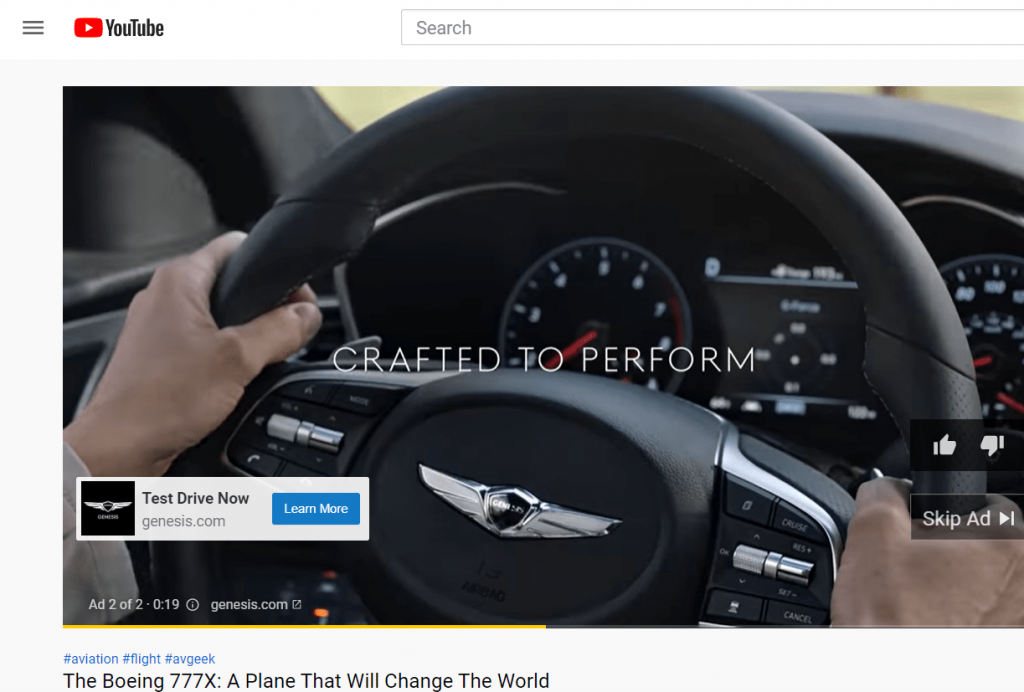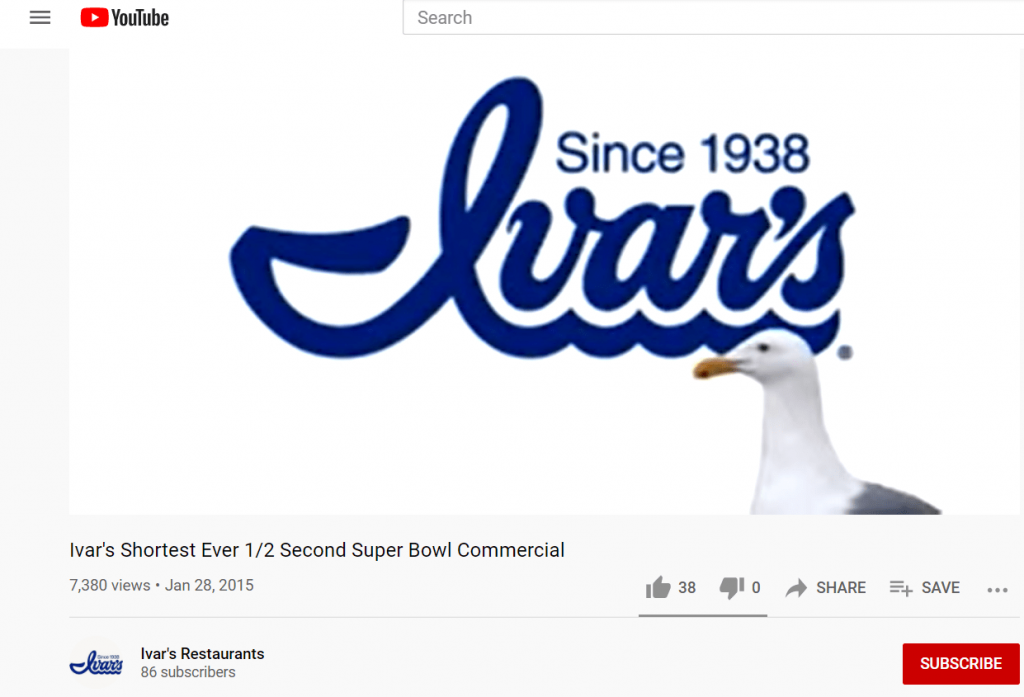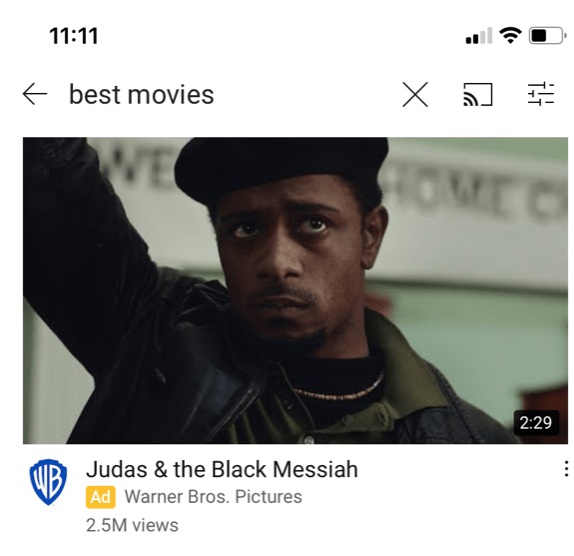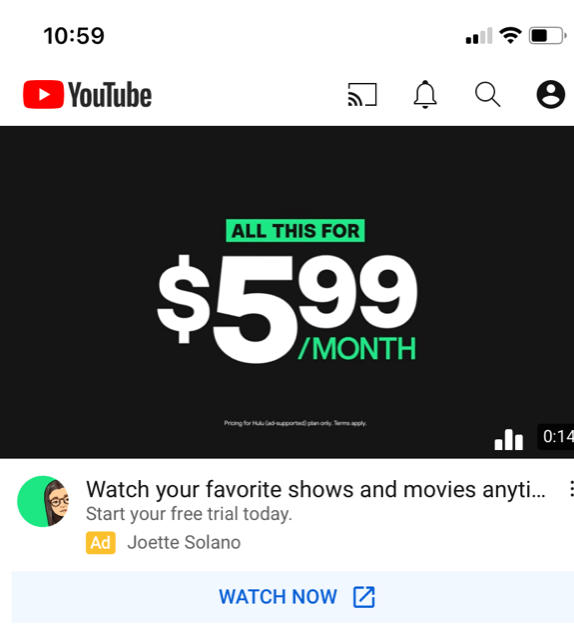A while back we gave a beginner’s overview on advertising on YouTube on the Fujisan blog. That piece included a quick look at the different ad types available, and recently we’ve been wanting to look at those closer.
So today, we’re focusing on just that — the ad types and their uses and benefits.
There are six choices when advertising on YouTube:
- Skippable in-stream ads
- Non-skippable in-stream ads
- Video discovery ads
- Bumper ads
- Outstream ads
- Masthead ads
Let’s start at the beginning with the first.
Skippable in-stream ads

Example of Skippable In-Stream Ad
These are pretty much exactly what they sound like: video ads shown before, during, or after videos that users can skip after five seconds.
The primary benefit of these ads is that they’re versatile and, because of their bidding mechanisms, quite low-risk. That is, you only pay if your ad plays for 30 seconds (or to the end of the video, whichever comes first) or if the viewer takes action by clicking on a link within your ad. This means that when viewers skip your ad before 30 seconds — which is typical if they’re going to skip — and don’t click on a link within it, you don’t pay at all. Heck yeah!
There’s also bidding options based on Target CPM, Target CPA, and Maximize conversion bidding, where you pay based on impressions. Along with the aforementioned bid option, you can see the versatility of these ad types.
It’s recommended with these ads that they’re a minimum of 12 seconds — any less and you’ll likely get charged for more people accidentally viewing them all the way through if they’re not fast enough to skip — while they’re capped at three minutes long maximum.
And then there’s their counterpart:
Non-skippable in-stream ads
Just like their skippable cousins, these are just what they sound like. Just like the skippable ads, these also play before, during, or after YouTube videos, but unlike skippable ads, their bidding options aren’t as versatile; non-skippable ads are bid on via Target CPM only, meaning you’re always paying based on impressions.
So why use non-skippable ads when you could use skippable ads that will probably give you a lot more free exposure?
The answer is that non-skippable ads are great when you want to deliver an entire message to the viewer that would otherwise be lost if they skipped five seconds into it. The ads deliver best when coupled with a call-to-action within them on which viewers can click, so you can capitalize on the attention you have from the viewer. That being said, these videos should be hyper-focused, clearly showcasing your brand or product’s value. Otherwise you’ll just annoy a bunch of people who aren’t going to have a clear takeaway even after being forced to watch your ad.
Video discovery ads
Example of Video Discovery Ad
Video discovery ads appear to the right of other videos, in YouTube search pages, or on websites on the Google Display Network, and you pay each time someone clicks on it.
These are also non-skippable video ads, but they differ from the in-stream ads in that viewers must actively click on them to watch.
At first your instinct might be “Well why would you do this when you can just use the normal non-skippable ads?” While that’s a reasonable first thought, the fact that viewers have to actively choose to watch your ad actually provides a sneaky advantage: those who watch your ad are self-selecting and already interested in you. This is in contrast with those who watch your non-skippable ads in-stream, who in most cases will have lower initial levels of interest. Because of this, people who watch these video ads versus the in-stream video ads are more likely to engage with them.
Another benefit of these is that they can really go more in-depth instead of focusing more on hooking the viewer in. Subsequently, they’re a really great place for tutorials, testimonials, or really any kind of more educational content.
Bumper ads are like the lil’ brothers of non-skippable in-stream ads. That’s because they are A) non-skippable but B) only six seconds long. Like the other in-stream ads, they play before, during, or after other videos.
These ones are awesome for super short, memorable messages. (If you’re reading this from the Seattle area, remember that .5 second Ivar’s Super Bowl commercial from, like, 2009? Yeah? Yeah.)

Ivar’s Super Bowl Commercial
Bumper ads are especially ideal for mobile viewers and are nice for remarketing to viewers who’ve watched other video ads of yours, or to otherwise complement larger video campaigns of yours. As you could probably guess, bidding for these are via Target CPM, where you pay based on impressions.
Outstream Ads
Unlike the other ad types we’ve mentioned up to now, outstream videos are exclusive to mobile users. These ads appear on partner sites and apps outside of YouTube, playing within either the app itself or, on partner sites on a mobile browser, within the content on the page.
These types of ads are well-suited to increasing brand awareness simply by getting your video ads in front of a bunch of people on a mobile or tablet platform. You’re charged only when someone watches your ad for two or more seconds.
Masthead Ads
Example of Masthead Ad
Lastly, we’ve got masthead ads. These are autoplaying video ads found at the top of the YouTube homepage, mobile app or browser, or YouTube TV app.
Just like outstream ads, these are really useful for increasing brand or product awareness; they won’t be as efficient as some of the other types like video discovery ads that are tailored to reach people already interested in you, but they’ll make up for that by simply reaching way more people. Generally speaking, these are for viewers who aren’t as far into the conversion funnel.
Because of how many viewers these reach, they’re available for either a fixed cost per day or a cost per thousand impressions. And important to remember, is that masthead ads are only available via reservation, which you have to do through a Google sales representative.
Between these six different ads, they cover a wide array of different purposes. You can reach a huge amount of people just to make them know you exist, or convince viewers who are in the process of deciding to buy your product that the right move is to pull the trigger. Given the scale of audience YouTube commands and humans’ visual nature, your business can do a whole lot with video advertising on YouTube.






